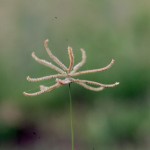Hooded Windmillgrass
Chloris cucullata
Poaceae
Description
This tufted, erect bunchgrass sometimes has short stolons. Its glabrous stems are flat as are its sheaths, and both are bluish green. The sheaths only cover about one-third of the internode and have white margins. Leaves are folded and about 5 to 20 cm long and 4 to 5 mm wide. The inflorescence has seven to eighteen stout, purplish terminal spikes borne in several closely spaced whorls at the culm apex (see Technical Note) that turn straw yellow or black when ripe. The 1.5 mm, two-floret spikelets are purple-tinged and crowded all the way to the base of the branches. There are short awns on the triangular spikelets. Hooded Windmillgrass tends to bloom in May and seed in August and September, though it can flower several times during the year. The seeds themselves appear inflated. Hooded Windmillgrass is a perennial, warm-season, native reaching 24 inches or 60 cm tall. Fair grazing for livestock and wildlife. According to an NRCS publication, it has a fairly high quality albeit low quantity forage.Habitat
Grows on upland sandy soils and disturbed areas; increases on overgrazed ranges following grazing deferment. The NRCS Fact Sheet states “It is adapted to acid to neutral medium- and coarse-textured soils. It does not do well on calcareous or clay soils.”Images
Plant Characteristics
Duration: Perennial
Stem Texture: Hairless/Smooth
Growth Habit: Bunch grass, Grasses
Season: Warm
Distribution
 : 02 - Gulf Prairies and Marshes, 04 - Blackland Prairies, 05 - Cross Timbers and Prairies, 06 - South Texas Plains, 07 - Edwards Plateau, 08 - Rolling Plains, 09 - High Plains, 10 - Trans-Pecos
: 02 - Gulf Prairies and Marshes, 04 - Blackland Prairies, 05 - Cross Timbers and Prairies, 06 - South Texas Plains, 07 - Edwards Plateau, 08 - Rolling Plains, 09 - High Plains, 10 - Trans-Pecos
Distributions
Distribution refers to the ecological region in Texas that a plant has been found. You can also view a clickable map.
Book: Know Your Grasses (B-182)
Collection: Grasses



